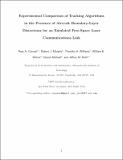Experimental Comparison of Tracking Algorithms in the Presence of Aircraft Boundary-Layer Distortions for an Emulated Free-Space Laser Communications Link
Author(s)
Williams, Timothy H.; Roth, Jeffrey M.; Murphy, Robert J.; Michael, Steven; Wilcox, William E., Jr.; Conrad, Ross A.; ... Show more Show less
DownloadRoth_experimental comparison.pdf (1.761Mb)
PUBLISHER_POLICY
Publisher Policy
Article is made available in accordance with the publisher's policy and may be subject to US copyright law. Please refer to the publisher's site for terms of use.
Alternative title
Experimental comparison of tracking algorithms in the presence of aircraft boundary-layer distortions for emulated free-space laser communication links
Terms of use
Metadata
Show full item recordAbstract
We report experiments comparing different focal plane array (FPA) tracking algorithms for emulated laser communication links between an aircraft and spacecraft. The links include look-angle-dependent phase disturbances caused by boundary-layer turbulence replicated by using a deformable mirror. Impairments from platform jitter, atmospheric scintillation, and propagation delay are also included. We study a hyperhemispherical dome geometry that provides a large field of regard but generates boundary-layer turbulence. Results from experiments comparing peak and centroid FPA tracking algorithms in various environments show that power delivered to the optical fiber varies with algorithm and look angle. An improvement in steady-state fiber-coupled power of up to 1.0 dB can be achieved through appropriate choice of algorithm. In a real system, this advantage could be realized by implementing a tracking processor that dynamically changes its tracking algorithm depending on look angle and other parameters correlated to boundary-layer turbulence.
Date issued
2008-12Department
Lincoln Laboratory; Massachusetts Institute of Technology. Department of Aeronautics and AstronauticsJournal
Applied Optics
Publisher
Optical Society of America
Citation
Ross A. Conrad, Robert J. Murphy, Timothy H. Williams, William E. Wilcox, Steven Michael, and Jeffrey M. Roth, "Experimental comparison of tracking algorithms in the presence of aircraft boundary-layer distortions for emulated free-space laser communication links," Appl. Opt. 48, A98-A106 (2009) http://www.opticsinfobase.org/abstract.cfm?URI=ao-48-1-A98
Version: Author's final manuscript
ISSN
0003-6935